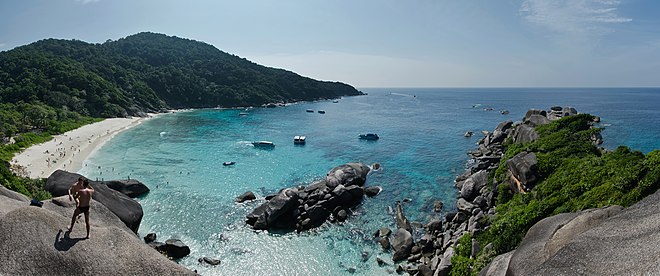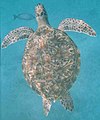Similan Islands
Access and tourism
Access to the Similan Islands is primarily through Tab Lamu Port, located just south of Khao Lak in Phang Nga Province. The park headquarters is situated in Tab Lamu, a small fishing village approximately 13 kilometres (8.1 mi) from Bang La On in Khao Lak. Regular boat services to the islands operate from the middle of October to the middle of May, with trips taking around three hours on standard boats and approximately 70 minutes by speedboat.
During the diving season, liveaboard dive boats frequent the Similan Islands. These boats, departing from Tab Lamu, Ko Lanta, Phuket, and Ranong, offer multi-day stays in the Similan National Marine Park.
The Similan Islands Park has experienced significant visitor traffic, making it one of Thailand's most overcrowded national parks. Data reported by the Department of National Parks (DNP) indicates that since October 2017, the park has received 883,438 visitors. The peak season, from mid-October to mid-May, typically sees five to six thousand visitors per day. The high visitor numbers have led to environmental degradation, prompting increased regulatory measures.
Annually, the park is closed during the rainy season, from 16 May to 15 October. Specifically, the island of Ko Tachai has been indefinitely closed to tourists since 15 October 2016 to facilitate environmental recovery. Following its re-opening on 15 October 2018, the park implemented a daily visitor limit of 3,850 to mitigate environmental impact. This measure represents a reduction from the previous average of about 7,000 visitors per day. In 2017, the park attracted approximately 912,000 tourists. The introduction of these restrictions has elicited responses from tour operators, who express concerns over potential job losses. Additionally, as part of the rehabilitation efforts, all overnight accommodations on the islands have been removed.
Geography


The islands are at 8°39′09″N 97°38′27″E / 8.65250°N 97.64083°E
The park is an archipelago consisting of 11 islands, occupying an area of 87,500 rai ~ 140 square kilometres (54 sq mi) with a land area of about 26 square kilometres (10 sq mi). For convenience, the Thai Department of National Parks (DNP) has assigned numbers to the islands. From north to south, they are:
- Island 11: Ko Tachai
- Island 10: Ko Bon, also known as Ko Talu
- Island 9: Ko Ba-ngu, also known as Ko Bayu
- Island 8: Ko Similan
- Island 7: Ko Hin Pousar
- Island 6: Ko Payu, also known as Ko Pa Yu
- Island 5: Ko Ha
- Island 4: Ko Miang, also known as Ko Meang. Park HQ is here.
- Island 3: Ko Payan, also known as Ko Pa Yan
- Island 2: Ko Payang, also known as Ko Pa Yang
- Island 1: Ko Huyong, also known as Ko Hu Yong

The Similans lie 70 kilometres off the coast of Phang Nga Province. "Similan" is a Yawi word meaning 'nine'. Ko Bon and Tachai were added to the national park in 1998.
Ko Similan: Ko Similan is the largest island. The sea in the area has an average depth of 60 feet. Underwater it is full of rock formations and coral reefs in several shapes and forms, resembling such things as deer, leaves, brains, and mushrooms. Above the water are found many diverse species such as the Nicobar pigeon, mangrove monitor lizards, flying fox and more.
Ko Huyong: Ko Huyong has the longest and widest beach in the park. However, the park prohibits any tourists from landing on the island as the beach is a place where turtles come to lay their eggs.
Wildlife protection

Within the Similan and Surin National Parks, specific islands, namely Islands 1, 2, and 3, are restricted from public access. This measure is in place to support a turtle hatching protection program and to aid in reef conservation efforts. Notably, Island number 3 is privately owned by a member of the Thai royal family.
Although fishing activities are officially prohibited in both Similan and Surin National Parks to protect marine life and habitats, observations suggest that fishing boats frequently operate in and around these parks. Divers in the area often report encountering fishing nets entangled in the reefs and illegal fishing traps. Recent years have seen an increase in the discovery of such illegal fishing equipment, particularly in areas outside the most frequented dive sites. These traps have been found to contain a variety of marine life, including trevallies, batfish, barracuda, golden pilot jacks, and triggerfish. Notably, the regions around Ko Bon and Ko Tachai have been identified as having a higher prevalence of these fishing traps.
Important Bird Area
The archipelago has been designated an Important Bird Area (IBA) by BirdLife International because it supports a population of Vulnerable pale-capped pigeons.
See also
- List of islands of Thailand
- List of national parks of Thailand
- List of Protected Areas Regional Offices of Thailand
References
- ^ "Similan Islands National Park". Tourism Authority of Thailand (TAT). Retrieved 31 May 2018.
- ^ Rujivanarom, Pratch (31 May 2018). "Ban on overnight stays at Similan islands from Oct". The Nation. Retrieved 31 May 2018.
- ^ "Koh Tachai island off Phangnga closed indefinitely". Bangkok Post. 2016-05-16. Retrieved 17 May 2016.
- ^ Rujivanarom, Pratch (15 October 2018). "Tight curbs on visitors to Similan". The Nation. Retrieved 15 October 2018.
- ^ WIpatayotin, Apinya (16 October 2018). "Parks officials refuse to budge over Similan quota". Bangkok Post. Retrieved 17 October 2018.
- ^ "ข้อมูลพื้นที่อุทยานแห่งชาติ ที่ประกาศในราชกิจจานุบกษา 133 แห่ง" [National Park Area Information published in the 133 Government Gazettes]. Department of National Parks, Wildlife and Plant Conservation (in Thai). December 2020. Retrieved 1 November 2022, no 43
{{cite web}}: CS1 maint: postscript (link) - ^ "Mu Ko Similan National Park" (PDF). Department of National Parks (DNP). Retrieved 31 May 2016.
- ^ "ABOUT THE SIMILAN ISLANDS". Similan Islands. Mu Ko Similan National Park of Thailand. Retrieved 17 May 2016.
- ^ "Mu Ko Similan". BirdLife Data Zone. BirdLife International. 2021. Retrieved 2 March 2021.


